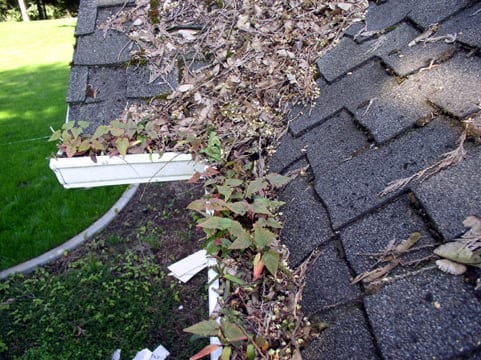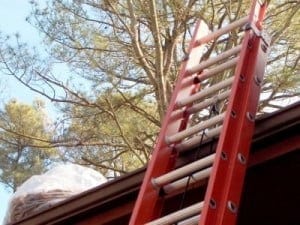 Well there is really no way to donate a simple yes or no answer to that question. But one thing is certain, & that is that rain gutters need to be unobstructed so that water can flow freely to the downspouts & be carried away from the house. If that doesn’t happen you are sure to run into serious problems in & around the house. But, if for some reason your gutters are not subjected to falling leaves & other debris such as branches, twigs, etc., then you may not need any type of protection, yet they should be checked occasionally. If your home does have trees near it & leaves blow onto your roof & into your gutters, & you are willing & able to clean the gutters out frequently then you may not need a gutter guard. And of course you could always pay someone to clean your gutters frequently once again eliminating the need for a guard. But let’s be realistic approximately the situation. It is very unlikely that your gutters will be cleaned frequently enough to assure that problems do not occur. And paying for cleanings frequently enough can run into some serious expense. And even when the situation is being handled frequently, there are things that can be overlooked. For example, downspouts can be clogged with leaves & that problem goes unnoticed because the clog is out of sight (and out of mind). While it may sound as if I am stating that there is a need for gutter guards, I am not. I am simply stating that gutters need to be free of leaves & other debris in order to function properly. Gutter guards may be the easiest & most economical way to make that happen.
Well there is really no way to donate a simple yes or no answer to that question. But one thing is certain, & that is that rain gutters need to be unobstructed so that water can flow freely to the downspouts & be carried away from the house. If that doesn’t happen you are sure to run into serious problems in & around the house. But, if for some reason your gutters are not subjected to falling leaves & other debris such as branches, twigs, etc., then you may not need any type of protection, yet they should be checked occasionally. If your home does have trees near it & leaves blow onto your roof & into your gutters, & you are willing & able to clean the gutters out frequently then you may not need a gutter guard. And of course you could always pay someone to clean your gutters frequently once again eliminating the need for a guard. But let’s be realistic approximately the situation. It is very unlikely that your gutters will be cleaned frequently enough to assure that problems do not occur. And paying for cleanings frequently enough can run into some serious expense. And even when the situation is being handled frequently, there are things that can be overlooked. For example, downspouts can be clogged with leaves & that problem goes unnoticed because the clog is out of sight (and out of mind). While it may sound as if I am stating that there is a need for gutter guards, I am not. I am simply stating that gutters need to be free of leaves & other debris in order to function properly. Gutter guards may be the easiest & most economical way to make that happen.
So, if you decide on using a gutter guard there are a few things to consider. There are many types of guards on the market, ranging from extremely expensive, to very cheap. The thing to remember is not to judge the performance based on the price. Some of the most expensive guards can actually cause more problems than they solve. So what should you look for? It certainly isn’t rocket science. Gutter guards need to be made of a sturdy material. The very cheapest ones can collapse into the gutter & become a catch point for debris to form a dam & block the flow of water. Avoid guards with gaps in the front because leaves can blow in the gaps, clog the gutters, & then cannot be reached in order to clean them out. Many of the gutter hoods are effective in light rain, yet can overflow during heavy downpours, & can moreover have the dreaded gap in front. And avoid anything that needs to be attached to the roof as this can affect your roofer’s warranty should a leak occur. So a sturdy guard that attaches only to the gutter, with perforations to allow only water into the gutter seems to be the most logical choice. Often times this is the most economical (not cheapest) way to go. If the installation is being done by a professional (highly recommended) be sure to obtain a written warranty & performance guarantee. Avoid contractors who do not specialize in gutters or those that make use of sub contractors. Doing this job right will allow you to have many years of trouble free performance.
loading...
loading...



 When it comes time to clean your gutters, aside from ladders, pressure washers, & a variety of buckets, there aren’t a lot of advertised products designed to reduce your overall time on the ladder. From robots to pressure washer attachments, scoops to gutter tongs, these products are designed to save you time & money, so maintaining vital efficiency of your gutters will be a much smoother & safer task.
When it comes time to clean your gutters, aside from ladders, pressure washers, & a variety of buckets, there aren’t a lot of advertised products designed to reduce your overall time on the ladder. From robots to pressure washer attachments, scoops to gutter tongs, these products are designed to save you time & money, so maintaining vital efficiency of your gutters will be a much smoother & safer task. When using a ladder to service your gutters or, honestly, for any reason at all, safety should always be your number one concern. Annually, there are approximately 222,000 people taken to the emergency room for ladder-related injuries. What’s more, many of these accidents occur because of improper ladder use, & could have been prevented simply by taking a few precautions before hopping on the ladder. Follow these guidelines for safe ladder usage & to prevent a trip to the hospital.
When using a ladder to service your gutters or, honestly, for any reason at all, safety should always be your number one concern. Annually, there are approximately 222,000 people taken to the emergency room for ladder-related injuries. What’s more, many of these accidents occur because of improper ladder use, & could have been prevented simply by taking a few precautions before hopping on the ladder. Follow these guidelines for safe ladder usage & to prevent a trip to the hospital.
You must be logged in to post a comment.